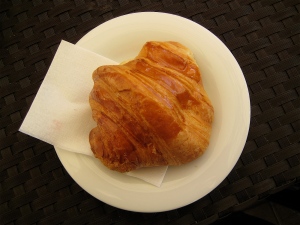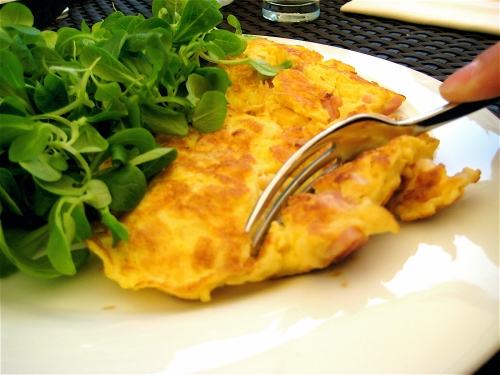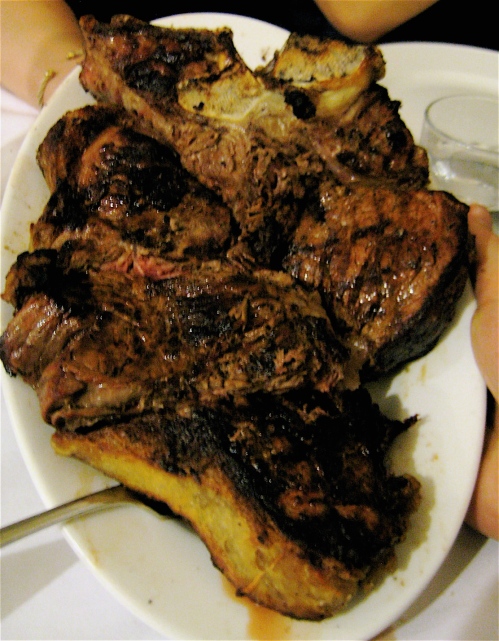The first pizza was born when a Neapolitan visionary put a tomato topping on flat pizza crust in the late 17th – 18th century. No cheese on the pizza….yet. Although flatbreads had been around for centuries, the Italians were the first to revolutionize plain flatbread and turn it into a versatile meal that can be modest or luxurious with the right selection of toppings. The pizza we know and love today, with oozing hot mozzarella cheese, rich tomato sauce, and toppings, evolved from its Italian ancestor, the Margherita pizza.

Old-timey Margherita pizza. myyyya ...see?
I was lucky enough to sample many varieties of pizza in several restaurants during my time in Naples- one of the benefits of traveling with other fellow pizza lovers who don’t mind sharing!
Pizzeria Brandi
Salita Sant’Anna di Palazzo, 1 (small street off of Via Chiaja), 80132 Napoli, Italia
Tucked away on a tiny side street is Pizzeria Brandi- where it all began in 1780. We are presented with royal blue menus with super fancy script font that takes forever to decipher, but indeed appears very regal. There are original pizzas and special pizzas, named after Italian icons such as Sofia Loren. Each menu has a lovely introductory story about the restaurant and how the pizza Margherita came to be.
The founder, Pietro Colicchio, first named the restaurant “Pietro…e basta cosi” (Peter… and that’s enough!). All subsequent managers were then referred to as “Pietro”, regardless of their real names. Kind of like how all Yankees managers would be called, Joe, after Joe Torre (lucky for current manager Joe Girardi who already fits the bill), according to present-day boyfriend Pietro. In 1889, King Umberto I and Queen Margherita di Savoia requested a sampling of pizza from Pizzeria Brandi, and later declared the Margherita pizza– made with mozzarella cheese, tomato sauce, and basil leaves to reflect the colors of the Italian flag–to be “excellent”. The restaurant still has the original letter framed.
 But first, an appetizer of buffalo mozzarella with pomodorini and arugola leaves. No sauce, no seasonings- the mozzarella and produce have enough flavor to stand alone. The buffalo mozzarella is juicy when you cut it, since it still retains a lot of liquid from being submerged in water, and it tastes very dense and rich, but mild.
But first, an appetizer of buffalo mozzarella with pomodorini and arugola leaves. No sauce, no seasonings- the mozzarella and produce have enough flavor to stand alone. The buffalo mozzarella is juicy when you cut it, since it still retains a lot of liquid from being submerged in water, and it tastes very dense and rich, but mild.
We order a few different pizzas- the Margherita, the Enrico Caruso (mozzarella, prosciutto with arugola), and a traditional seafood pizza. Beverages include red house wine and mineral water.
The Margherita pizza (below, left) definitely lives up to its name of being the first of its kind. The fresh mozzarella is melted, with some of the leftover moisture from the cheese running throughout the pizza and combining with the other ingredients. The mozzarella cheese is added in chunks and spread out, as opposed to many pizzas we see today, with cheese spread throughout the pizza and reaching the crust to produce a complete cheesy cover.



Pietro...and Pietro! Courtesy of B. Mannisi!
The Enrico Caruso pizza (above, right), named after the famous Italian tenor, features a combination of sliced pomodorini (mini tomatoes), arugola, mozzarella, and thin-sliced prosciutto (no sauce). In Italy, pizza is often eaten by cutting it with a knife and fork, which works well with this pizza since the toppings are all loose. This is a common pizza in Naples in terms of the ingredient combinations, but the freshness is what counts. There is a little too much dough for my taste, which fills me up quickly, so I cut around the crusts, and enjoy the toppings.
 Present-day boyfriend Pietro gets the traditional seafood pizza (left), with a simple layer of fragrant tomato sauce and a generous helping of seafood toppings. There are baby octopuses with their eight little tentacles intact, squid, clams, mussels, and basil. When you first taste it, it almost feels like something is missing. It’s really good. But I was told this is pizza. Where is the melted pizza cheese? Well, you just have to embrace the original. I’m sure Italians come to America and think, Why is there so much cheese? Cheese everywhere! You can’t taste anything else!
Present-day boyfriend Pietro gets the traditional seafood pizza (left), with a simple layer of fragrant tomato sauce and a generous helping of seafood toppings. There are baby octopuses with their eight little tentacles intact, squid, clams, mussels, and basil. When you first taste it, it almost feels like something is missing. It’s really good. But I was told this is pizza. Where is the melted pizza cheese? Well, you just have to embrace the original. I’m sure Italians come to America and think, Why is there so much cheese? Cheese everywhere! You can’t taste anything else!
Ristorante Mattozzi
Piazza Carita 2, 80134 Napoli, Italia
Founded in 1832, Ristorante Mattozzi also boasts historically amazing pizza. I order the spaghetti vongole (bottom, left), which has a little more red sauce than the previous version from Ciro a Medina. The spaghetti vongole here is, in the words of Queen Margherita di Savoia, “excellent”. The pizzas is fantastic, and has a very flavorful tomato sauce to build on. The crust is puffy and chewy, a higher crust-pizza ratio than the others.


 Most pizzerias in Naples have the option of adding buffalo mozzarella for an additional charge, or offer a pizza that uses buffalo mozzarella exclusively (above, right). These pizzas are especially rich. We also get a pizza with prosciutto, tomato sauce, cheese, and basil, (left) which is great.
Most pizzerias in Naples have the option of adding buffalo mozzarella for an additional charge, or offer a pizza that uses buffalo mozzarella exclusively (above, right). These pizzas are especially rich. We also get a pizza with prosciutto, tomato sauce, cheese, and basil, (left) which is great.
Pizzeria Sofi
Via Cristoforo Colombo, 3 80133 Napoli, Italia
Hunger and hunger-driven intuition leads us to Pizzeria Sofi, with surprising, yet wonderful results. We are famished after our long train ride from Bologna and decide to walk straight from our hotel to the port area of Naples to find something, anything, to eat. The pizza at Sofi is slightly different from the centuries-old pizza restaurants we tried. Its pizza crust is even thinner, with more cheese spread throughout the entire surface of the pizza. I think it is closer to the pizza we are used to today but with an a paper thin crust, high quality ingredients, and flavors that come together very organically. All in all, a terrific pizza. I dare say one of the best I’ve had in Italy so far.
I really want to try one of the anchovy pizzas, since southern Italy (namely Sicily) is known for its anchovies. It is called a pizza romana here (below), which is really strange considering most pizzas with anchovies (at least in the north) are called pizza siciliana. The pizza siciliana in opposite-world Pizzeria Sofi is an eggplant pizza. Pietro’s dad asks why pizza siciliana here has eggplant and the waiter said, “because eggplant is good in Sicily.” Fair enough!

 Yummm the anchovy pizza here is incredible! Pietro orders the quattro stagioni (four seasons) pizza (below), separated into four corresponding sections with mushroom, prosciutto cotto (cooked prosciutto…really good ham, essentially), artichoke, and four cheeses. I once asked a waiter which season corresponded to which topping, and he said that it wasn’t literally a representation of four seasons but a selection of the different pizza ingredients the chef wants to put on the pizza. I guess sometimes when you really want there to be a story behind something, there is none and that’s that. Unless he just didn’t know, which is quite possible.
Yummm the anchovy pizza here is incredible! Pietro orders the quattro stagioni (four seasons) pizza (below), separated into four corresponding sections with mushroom, prosciutto cotto (cooked prosciutto…really good ham, essentially), artichoke, and four cheeses. I once asked a waiter which season corresponded to which topping, and he said that it wasn’t literally a representation of four seasons but a selection of the different pizza ingredients the chef wants to put on the pizza. I guess sometimes when you really want there to be a story behind something, there is none and that’s that. Unless he just didn’t know, which is quite possible.


Trattoria Medina
Via Medina, 32 80133 Napoli, Italy
I have to bring this pizza back from the previous post (despite the poor photography on this one)- it is too good. I would just like to reiterate how fantastic fresh (not like a newly-opened Polly-O-string-cheese-wrapper type of fresh, but dripping-with-the-cheese-water-it-was-conceived-in type fresh) Italian cheese is on pizza. Particularly this ricotta. It is pretty inspirational, actually. Makes me want to experiment with making my own cheese at home. (And now that I have written it down, I guess I’ll have to follow through at some point!)

Pizza has come a long way since its humble beginnings as glorified flatbread. In the 19th century, the Florentine author of Pinocchio, Carlo Collodi, aka one of the first food “bloggers”, remarked that all of the toppings, bits of cheese, and tomato made Neapolitan pizza look just like the “complicated filth” of the city*. Although I suppose people still crack jokes about the humble pizza, (Jack Donaghy from the amazing show 30 Rock referred to it as, “greasy peasant food”), pizza has prevailed. It can be found in many corners of the world, adapted to the preferred ingredients and tastes of fans from all different countries, and in fact, it is now an (if not THE) Italian icon…right next to Sofia Loren and the famous Italian tenor Enrico Caruso that my pizza was named after.
* Capatti, Alberto and Montanari, Massimo. Italian Cuisine: A Cultural History. New York: Columbia University Press, 2003.

Jack Donaghy!
Check out this pizza from Japan, at 646 calories a slice:
Looks like America better step it up!
 In the U.S., spaghetti bolognese consists of spaghetti with tomato sauce and ground beef. During my few weeks in Bologna so far, I’ve tried many versions of the original ragu bolognese, city’s most prized and well-known sauce. Instead of spaghetti, it is served with fresh tagliatelle— long, ribbon-shaped pasta that is made with flour and eggs. Since it is freshly-made, the pasta is especially porous which makes it ideal for soaking up delicious, rich sauces.
In the U.S., spaghetti bolognese consists of spaghetti with tomato sauce and ground beef. During my few weeks in Bologna so far, I’ve tried many versions of the original ragu bolognese, city’s most prized and well-known sauce. Instead of spaghetti, it is served with fresh tagliatelle— long, ribbon-shaped pasta that is made with flour and eggs. Since it is freshly-made, the pasta is especially porous which makes it ideal for soaking up delicious, rich sauces. 4. Add the wine, a little stock, and the tomato paste. I also added a cup of canned whole tomatoes that I broke apart, because I like more tomato in my sauce, though it is not in the original recipe.
4. Add the wine, a little stock, and the tomato paste. I also added a cup of canned whole tomatoes that I broke apart, because I like more tomato in my sauce, though it is not in the original recipe.































































